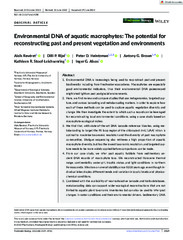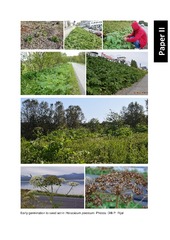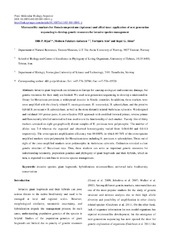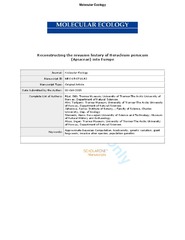Blar i forfatter "Rijal, Dilli Prasad"
-
Environmental DNA of aquatic macrophytes: The potential for reconstructing past and present vegetation and environments
Revéret, Aloïs Nicolas; Rijal, Dilli Prasad; Heintzman, Peter D.; Brown, Antony Gavin; Stoof-Leichsenring, Kathleen R.; Alsos, Inger Greve (Journal article; Tidsskriftartikkel; Peer reviewed, 2023-07-29)1. Environmental DNA is increasingly being used to reconstruct past and present biodiversity including from freshwater ecosystems. Macrophytes are especially good environmental indicators, thus their environmental DNA palaeorecord might shed light on past postglacial environments.<p> <p>2. Here, we first review and compare studies that use metagenomics, targeted capture, and various barcoding ... -
Forest canopy resists plant invasions: a case study of Chromolaena odorata in Sal (Shorea robusta) forests of Nepal
Sharma, Lila Nath; Adhikari, B.; Watson, M.F.; Shrestha, B.B.; Paudel, E.; Karna, B.; Rijal, Dilli Prasad (Journal article; Tidsskriftartikkel; Peer reviewed, 2022-01-07)Invasive alien species are a major threat to global biodiversity due to the tremendous ecological and economic damage they cause in forestry, agriculture, wetlands, and pastoral resources. Understanding the spatial pattern of invasive alien species and disentangling the biophysical drivers of invasion at the forest stand level is essential for managing forest ecosystems and the wider landscape. ... -
Giant invasive Heracleum persicum: Friend or foe of plant diversity?
Rijal, Dilli Prasad; Alm, Torbjørn; Nilsen, Lennart; Alsos, Inger Greve (Journal article; Tidsskriftartikkel; Peer reviewed, 2017-05-30)The impact of invasion on diversity varies widely and remains elusive. Despite the con- siderable attempts to understand mechanisms of biological invasion, it is largely un- known whether some communities’ characteristics promote biological invasion, or whether some inherent characteristics of invaders enable them to ... -
Holocene summer temperature reconstruction from plant sedaDNA and chironomids from the northern boreal forest
Mayfield, Roseanna J.; Rijal, Dilli Prasad; Heintzman, Peter D.; Langdon, Peter G.; Karger, Dirk N.; Brown, Antony Gavin; Alsos, Inger Greve (Journal article; Tidsskriftartikkel; Peer reviewed, 2024-10-30)Climate-induced ecotonal shifts are expected to occur in the (sub)arctic and boreal zones in the coming decades. Understanding how these ecosystems have previously responded to climate change can provide greater insight into how ecosystems may develop under existing and future pressures. Here we present a Holocene record from Lake Horntjernet, a lake on the northern edge of the boreal forest in ... -
Invasive Heracleum in northern Europe: Introduction history and impact on native plant diversity
Rijal, Dilli Prasad (Doctoral thesis; Doktorgradsavhandling, 2016-01-15)Exotic invasive giant hogweeds are infamous in Europe for their ecological and economic damage; however, the magnitude of their impact on plant diversity has not yet been fully explored. In addition, uncertainties in their source and route of introduction impede management interventions. In such cases, molecular markers may bridge gaps between invasion history and management by providing insight ... -
Microsatellite markers for Heracleum persicum (Apiaceae) and allied taxa: application of next-generation sequencing to develop genetic resources for invasive species management
Rijal, Dilli Prasad; Falahati-Anbaran, Mohsen; Alm, Torbjørn; Alsos, Inger Greve (Journal article; Tidsskriftartikkel; Peer reviewed, 2014) -
Paleoeconomy more than demography determined prehistoric human impact in Arctic Norway
Brown, Antony; Rijal, Dilli Prasad; Heintzman, Peter D.; Clarke, Charlotte, L.; Blankholm, Hans Peter; Høeg, Helge I.; Lammers, Youri; Bråthen, Kari Anne; Edwards, M E; Alsos, Inger Greve (Journal article; Tidsskriftartikkel; Peer reviewed, 2022-10-07)Population size has increasingly been taken as the driver of past human environmental impact worldwide, and particularly in the Arctic. However, sedimentary ancient DNA (sedaDNA), pollen and archaeological data show that over the last 12,000 years, paleoeconomy and culture determined human impacts on the terrestrial ecology of Arctic Norway. The large Mortensnes site complex (Ceavccagea ¯dgi, 70◦N) ... -
Postglacial species arrival and diversity buildup of northern ecosystems took millennia
Alsos, Inger Greve; Rijal, Dilli Prasad; Ehrich, Dorothee; Karger, Dirk Nikolaus; Yoccoz, Nigel; Heintzman, Peter D.; Brown, Antony; Lammers, Youri; Pellissier, Loïc; Alm, Torbjørn; Bråthen, Kari Anne; Coissac, Eric; Merkel, Marie Føreid; Alberti, Adriana; Denoeud, France; Bakke, Jostein (Journal article; Tidsskriftartikkel; Peer reviewed, 2022-09-28)What drives ecosystem buildup, diversity, and stability? We assess species arrival and ecosystem changes across 16 millennia by combining regional-scale plant sedimentary ancient DNA from Fennoscandia with near-complete DNA and trait databases. We show that postglacial arrival time varies within and between plant growth forms. Further, arrival times were mainly predicted by adaptation to temperature, ... -
Reconstructing the invasion history of Heracleum persicum (Apiaceae) into Europe
Rijal, Dilli Prasad; Alm, Torbjørn; Jahodová, Šárka; Stenøien, Hans K.; Alsos, Inger Greve (Journal article; Tidsskriftartikkel, 2015-11-06)Sparse, incomplete and inappropriate historical records of invasive species often hamper invasive species management interventions. Population genetic analyses of invaders might provide a suitable context for the identification of their source populations and possible introduction routes. Here, we describe the population genetics of Heracleum persicum Desf. ex Fisch and trace its route of introduction ... -
Sedimentary ancient DNA reveals local vegetation changes driven by glacial activity and climate.
Elliott, Lucas Dane; Rijal, Dilli Prasad; Brown, Antony; Bakke, Jostein; Topstad, Lasse; Heintzman, Peter D.; Alsos, Inger Greve (Journal article; Tidsskriftartikkel; Peer reviewed, 2023-01-07)Disentangling the effects of glaciers and climate on vegetation is complicated by the confounding role that climate plays in both systems. We reconstructed changes in vegetation occurring over the Holocene at Jøkelvatnet, a lake located directly downstream from the Langfjordjøkel glacier in northern Norway. We used a sedimentary ancient DNA (sedaDNA) metabarcoding dataset of 38 samples from a ... -
Sedimentary ancient DNA shows terrestrial plant richness continuously increased over the Holocene in northern Fennoscandia
Rijal, Dilli Prasad; Heintzman, Peter D.; Lammers, Youri; Yoccoz, Nigel; Lorberau, Kelsey; Pitelkova, Iva; Goslar, Tomasz; Murguzur, Francisco Javier Ancin; Salonen, J. Sakari; Helmens, Karin F.; Bakke, Jostein; Edwards, Mary E.; Alm, Torbjørn; Bråthen, Kari Anne; Brown, Antony; Alsos, Inger Greve (Journal article; Tidsskriftartikkel; Peer reviewed, 2021-07-30)The effects of climate change on species richness are debated but can be informed by the past. Here, we generated a sedimentary ancient DNA dataset covering 10 lakes and applied novel methods for data harmonization. We assessed the impact of Holocene climate changes and nutrients on terrestrial plant richness in northern Fennoscandia. We find that richness increased steeply during the rapidly warming ... -
Uncovering Holocene climate fluctuations and ancient conifer populations: Insights from a high-resolution multi-proxy record from Northern Finland
Salonen, J. Sakari; Kuosmanen, Niina; Alsos, Inger Greve; Heintzman, Peter D.; Rijal, Dilli Prasad; Schenk, Frederik; Bogren, Freja; Luoto, Miska; Philip, Annemarie; Piilo, Sanna; Trasune, Liva; Väliranta, Minna; Helmens, Karin F. (Journal article; Tidsskriftartikkel; Peer reviewed, 2024-05-08)A series of abrupt climate events linked to circum-North Atlantic meltwater forcing have been recognised in Holocene paleoclimate data. To address the paucity of proxy records able to characterise robustly the regional impacts of these events, we retrieved a sub-centennial resolution, well-dated core sequence from Lake Kuutsjarvi, ¨ northeast Finland. By analysing a range of paleo-environmental ... -
Using ancient sedimentary DNA to forecast ecosystem trajectories under climate change
Alsos, Inger Greve; Boussange, Victor; Rijal, Dilli Prasad; Beaulieu, Marieke-Lise; Brown, Antony Gavin; Herzschuh, Ulrike; Svenning, Jens-Christian; Pellissier, Loïc (Journal article; Tidsskriftartikkel; Peer reviewed, 2024-05-27)Ecosystem response to climate change is complex. In order to forecast ecosystem dynamics, we need high-quality data on changes in past species abundance that can inform process-based models. Sedimentary ancient DNA (sedaDNA) has revolutionised our ability to document past ecosystems' dynamics. It provides time series of increased taxonomic resolution compared to microfossils (pollen, spores), and ...


 English
English norsk
norsk











